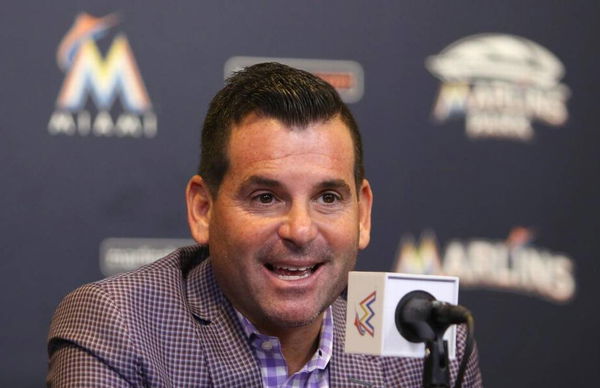

The stands were almost empty. Not because the weather was bad and because the bullpen was on a losing streak. The scoreboard was alive, the players were sharp—but the crowd? Nearly invisible. A sight like that makes you wonder: if baseball is still called “America’s pastime”, why does it feel like fewer people are passing the time with it?
Now, an insider has stepped up with a reality check—one that flips the script on what we think matters in the MLB. Former Marlins president and longtime insider, David Samson, has blatantly declared that traditional attendance statistics are “absolutely meaningless”. If that sounds harsh, wait till you hear his reasoning. He’s not just slapping holes—he’s providing a whole new lens.
It is time to break it down from the top—what did David Samson really mean by “absolutely meaningless”? To make it simple: it is not related to how many individuals show up to the stadium. However, how much each one is worth depends on the bottom line. At the period of his commentary, he provided a powerful instance. He said, “a hundred people who spend a dollar is the same as one person who spends a hundred”. It is not rocket science, however, it is a business truth that many still ignore. His message is clear: chasing high attendance without benefit is a flawed approach.
ADVERTISEMENT
Article continues below this ad
So, why is David Samson saying this now? Because empty seats are becoming too basic. In addition, MLB can not afford to pretend the old approach still works. He highlights that with every extra body in the field comes extra costs—ushers, security, parking and concessions. If those fans are low spenders? The math just does not add up. Instead of stretching to fill the gaps, Samson asked to aim at high-value fans who pay extra for premium experiences, no matter how less they are in number. That, in his thought process, is the future of sustainable baseball economics.
Poll of the day
Poll 1 of 5
AD
Moving on to the where and when—this shift in thinking is emerging at a time when clubhouses like the Miami Marlins are experiencing a drop-off in attendance. Stadiums structured to hold 35,000+ are barely seeing 7,000 fans walk through the gates. Yet despite these low figures, some games are still marked “sold out”. How? Because people buy tickets and never show up. Samson describes that those fans still count as “paid attendance,” but unless they’re in all-inclusive areas with prepaid concessions, that ticket revenue is where the profit ends.
This is precisely how Samson predicts a smarter model. It’s not about loading as multiple people as possible into a ballpark—it’s about making sure those who do come in are already paid up in ways that guarantee several revenue streams. He champions “revenue certainty”—a concept where supporters prepay for suites, food, drinks, and merchandise, which gives the team income regardless of turnout. “It gives me revenue certainty and I don’t care if they show up or not“, Samson candidly adds. That kind of blunt honesty might fringe traditionalists, but in pure business terms, it’s solid gold.
And ultimately, who is this really about? Not just David Samson. It’s about every franchise struggling to fill huge stadiums in an age where fans have endless digital alternatives. Samson’s pitch is not personal—it’s practical. He’s not here to thump the game. He’s trying to save its future by pushing for smaller, smarter ballparks that reflect the new normal. Less overhead, more value. Fewer fans, more revenue. It’s implausible—but it might just be the play MLB badly needs to run.
ADVERTISEMENT
Article continues below this ad
What the Marlins and others can learn from tech-driven teams
While some argue attendance is “absolutely meaningless”, others in the league are saying that it’s not the number of people in seats that matters—it is how smartly you get them there. Look no further than the Houston Astros. Years before their World Series run, they leaned heavily into data analytics—not just to enhance their roster, but to fill the stands. The Astros investigated fan demographics, purchasing patterns, and even location-based behaviors. This enables them to tailor their messaging: discounted family nights, last-minute ticket drops for local fans, or VIP invites for corporate spenders. It wasn’t trial-and-error; it was calculated marketing.
What’s your perspective on:
Should MLB teams focus on high-value fans over filling seats? Is this the future of baseball?
Have an interesting take?
But the Astros weren’t alone in this tech-driven ticket revolution.
The San Francisco Giants also reinforced their game by turning their ballpark into a fan-experience lab. Bob Melvin’s team used real-time data to optimize everything—from ticket pricing to in-stadium food and beverage sales. Their CRM system tracked fan preferences down to the type of beer a season ticket holder liked. If a certain section was regularly half-empty, they’d geo-target those local neighborhoods with flash promotions. Their digital team even experimented with dynamic pricing, adjusting ticket costs like airline seats based on demand surges or opponent popularity. The outcomes? Fewer empty seats and stronger per-cap revenue—truly what teams like the Marlins should be focused on.
ADVERTISEMENT
Article continues below this ad
So while some may downplay attendance as just a vanity stat, teams like the Astros and Giants are showing that when used correctly, data can make every ticket count. For the Marlins, it’s not about fabricating bigger or even filling every seat—it’s about knowing who your fan is, where they are and how to make them feel like the stadium was built just for them.
Top Stories
ADVERTISEMENT
ADVERTISEMENT
ADVERTISEMENT
ADVERTISEMENT


Should MLB teams focus on high-value fans over filling seats? Is this the future of baseball?